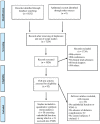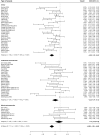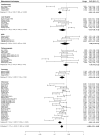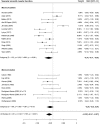Early Endothelial Dysfunction in Type 1 Diabetes Is Accompanied by an Impairment of Vascular Smooth Muscle Function: A Meta-Analysis
- PMID: 32362871
- PMCID: PMC7180178
- DOI: 10.3389/fendo.2020.00203
Early Endothelial Dysfunction in Type 1 Diabetes Is Accompanied by an Impairment of Vascular Smooth Muscle Function: A Meta-Analysis
Abstract
Background: A large yet heterogeneous body of literature exists suggesting that endothelial dysfunction appears early in type 1 diabetes, due to hyperglycemia-induced oxidative stress. The latter may also affect vascular smooth muscles (VSM) function, a layer albeit less frequently considered in that pathology. This meta-analysis aims at evaluating the extent, and the contributing risk factors, of early endothelial dysfunction, and of the possible concomitant VSM dysfunction, in type 1 diabetes. Methods: PubMed, Web of Sciences, Cochrane Library databases were screened from their respective inceptions until October 2019. We included studies comparing vasodilatory capacity depending or not on endothelium (i.e., endothelial function or VSM function, respectively) in patients with uncomplicated type 1 diabetes and healthy controls. Results: Fifty-eight articles studying endothelium-dependent function, among which 21 studies also assessed VSM, were included. Global analyses revealed an impairment of standardized mean difference (SMD) (Cohen's d) of endothelial function: -0.61 (95% CI: -0.79, -0.44) but also of VSM SMD: -0.32 (95% CI: -0.57, -0.07). The type of stimuli used (i.e., exercise, occlusion-reperfusion, pharmacological substances, heat) did not influence the impairment of the vasodilatory capacity. Endothelial dysfunction appeared more pronounced within macrovascular than microvascular beds. The latter was particularly altered in cases of poor glycemic control [HbA1c > 67 mmol/mol (8.3%)]. Conclusions: This meta-analysis not only corroborates the presence of an early impairment of endothelial function, even in response to physiological stimuli like exercise, but also highlights a VSM dysfunction in children and adults with type 1 diabetes. Endothelial dysfunction seems to be more pronounced in large than small vessels, fostering the debate on their relative temporal appearance.
Keywords: endothelial function; exercise; macrocirculation; microcirculation; peripheral vascular disease; smooth muscle function; type 1 diabetes.
Copyright © 2020 Lespagnol, Dauchet, Pawlak-Chaouch, Balestra, Berthoin, Feelisch, Roustit, Boissière, Fontaine and Heyman.
Figures






Similar articles
-
Metabolic syndrome individuals with and without type 2 diabetes mellitus present generalized vascular dysfunction: cross-sectional study.Arterioscler Thromb Vasc Biol. 2015 Apr;35(4):1022-9. doi: 10.1161/ATVBAHA.114.304591. Epub 2015 Feb 5. Arterioscler Thromb Vasc Biol. 2015. PMID: 25657309 Clinical Trial.
-
Deterioration of endothelial function of micro- and macrocirculation in patients with diabetes type 1 and 2.Int Angiol. 2017 Aug;36(4):354-361. doi: 10.23736/S0392-9590.16.03798-6. Epub 2016 Dec 20. Int Angiol. 2017. PMID: 28001011
-
Knockout of vascular smooth muscle EGF receptor in a mouse model prevents obesity-induced vascular dysfunction and renal damage in vivo.Diabetologia. 2020 Oct;63(10):2218-2234. doi: 10.1007/s00125-020-05187-4. Epub 2020 Jun 17. Diabetologia. 2020. PMID: 32548701 Free PMC article.
-
[Endothelial dysfunction in type 1 diabetes].Arq Bras Endocrinol Metabol. 2008 Mar;52(2):416-26. doi: 10.1590/s0004-27302008000200030. Arq Bras Endocrinol Metabol. 2008. PMID: 18438553 Review. Portuguese.
-
Diabetic angiopathy: tracking down the culprits.J Diabetes Complications. 1996 May-Jun;10(3):173-81. doi: 10.1016/1056-8727(96)00035-9. J Diabetes Complications. 1996. PMID: 8807468 Review. No abstract available.
Cited by
-
Vascular deficits contributing to skeletal fragility in type 1 diabetes.Front Clin Diabetes Healthc. 2023 Oct 6;4:1272804. doi: 10.3389/fcdhc.2023.1272804. eCollection 2023. Front Clin Diabetes Healthc. 2023. PMID: 37867730 Free PMC article. Review.
-
Nitric oxide-mediated vasodilation in human bone.Microcirculation. 2024 Feb;31(2):e12842. doi: 10.1111/micc.12842. Epub 2023 Dec 22. Microcirculation. 2024. PMID: 38133925 Free PMC article.
-
Biochemical and clinical markers of endothelial dysfunction do not outweigh traditional risk factors for the presence of diabetic retinopathy in patients with type 1 diabetes.Diabetol Metab Syndr. 2022 Sep 27;14(1):141. doi: 10.1186/s13098-022-00912-y. Diabetol Metab Syndr. 2022. PMID: 36167607 Free PMC article.
-
The Role of Endothelial Progenitor Cells (EPCs) and Circulating Endothelial Cells (CECs) as Early Biomarkers of Endothelial Dysfunction in Children with Newly Diagnosed Type 1 Diabetes.Cells. 2025 Jul 17;14(14):1095. doi: 10.3390/cells14141095. Cells. 2025. PMID: 40710348 Free PMC article.
-
Effect of sulfasalazine on endothelium-dependent vascular response by the activation of Nrf2 signalling pathway.Front Pharmacol. 2022 Oct 24;13:979300. doi: 10.3389/fphar.2022.979300. eCollection 2022. Front Pharmacol. 2022. PMID: 36353481 Free PMC article.
References
Publication types
MeSH terms
LinkOut - more resources
Full Text Sources
Medical
Miscellaneous

